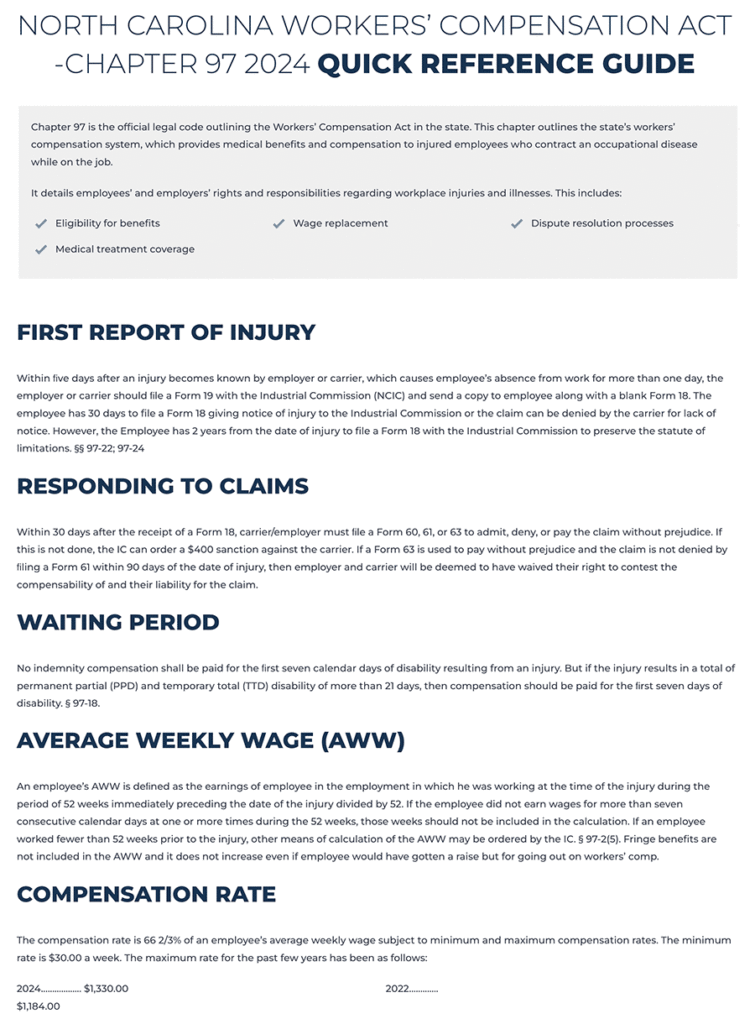Learn about the 4 types of workers’ comp benefits for injured workers and their families
Following a work-related accident, injury or illness, it’s common for injured workers and their families to stress about how they will make ends meet. The unpaid bills piling up on the kitchen table—for medical care, rent or mortgage, and other living expenses—can seem even more overwhelming and worrisome when you’re out of work recovering and not earning a paycheck.
The good news is that most workers in North Carolina are covered by the state’s workers’ compensation system, which requires all businesses that employ 3 or more employees to carry insurance coverage in case a worker is injured on the job. As a no-fault system, workers’ compensation is designed to provide compensation to injured workers quickly and efficiently, if everything goes right.
In order to understand how much you can get from workers’ compensation in North Carolina, you first need to know about the different types of benefits that you may be owed. If you have more questions about your rights, don’t hesitate to consult with an experienced Charlotte workers’ compensation attorney at Wilder Law Group for answers.
What are workers’ compensation benefits?
In the world of workers’ compensation, the term “benefits” refers to the financial compensation awarded to injured workers for the costs associated with their job-related injury or occupational illness. Workers’ comp benefits are awarded on a no-fault basis, meaning it doesn’t matter who’s fault the work accident or illness was. In fact, you are entitled to benefits in North Carolina even if you were partially or fully responsible for your injury.
Workers’ compensation benefits not only pay for the medical costs required to diagnose and treat your work-related health condition, but these benefits can also provide temporary or permanent income replacement (or “disability”) payments while you are out of work recovering.
What are the 4 types of workers’ compensation benefits?
If you or a loved one are injured in the workplace, then the workers’ compensation benefits you may receive in North Carolina fall into these 4 categories:
- Medical benefits
- Indemnity benefits (also known as “lost wages” or “disability”)
- Vocational rehabilitation benefits
- Death benefits
Continue reading to learn more about each of these types of benefits.
1. Medical expenses
Workers’ compensation provides medical benefits that help injured workers pay for any past and future medical bills and health care expenses that arise due to their work-related injury or illness.
In North Carolina, the employer (or the employer’s workers’ compensation insurance company) is allowed to direct medical treatment for the injured worker by choosing their doctor. However, the injured worker may petition the Industrial Commission to change doctors. It’s important to go through this petition process before seeing another non-authorized physician, otherwise workers’ compensation may not cover medical expenses from this doctor.
If you travel 20 miles or more (round-trip) for medical care, then you may collect compensation for travel at a rate of 54 cents per mile (on or after January 1, 2016).
To help your attorney add up all of these expenses, be sure to keep a record of all your medical costs. Your attorney can also help you get a second opinion if you aren’t satisfied with your doctor’s care.
2. Indemnity benefits (lost wages)
If you were injured to the point that you are unable to return to work temporarily or permanently, then you may be eligible for compensation for some of this lost income. How much and how long you may receive these benefits depends on the severity of your injury and other factors. Disability benefits are based on your average weekly wage (AWW).
According to the Workers’ Compensation Act:
“The term ‘disability’ means incapacity because of injury to earn the wages which the employee was receiving at the time of injury in the same or any other employment.”
Indemnity benefits are not awarded for the first 7 days of missed work unless your injury causes you to miss at least 21 days.
In other words, if you miss 21 days of work or more, then you will be paid for days 1-7; otherwise, you will only start getting paid benefits for missed days starting on day 8.
Lost wage benefits are typically paid on a weekly basis, though monthly payments can be authorized in certain circumstances. If eligible for indemnity benefits, you will receive them until you are able to return to work.
Temporary partial disability (TPD)
If the injured worker is able to return to work but at lesser wages than before their injury, then they may want to consider taking temporary partial disability, which is two-thirds (66 ⅔ percent) of the difference between the pre-injury average weekly wage and the post-injury average weekly wage. TPD is intended to help “bridge the gap” between what you earned before you were hurt and now (post-injury).
For example, let’s say you earned $600 per week prior to your injury. After your accident, you were forced to work on light duty and only make half of what you did before—$300 per week. In this case, you would receive $200 per week in TPD benefits until you were able to resume normal hours. Thus, your total weekly post-injury income would be $500 with TPD—less than your pre-injury wage, but better than $300.
Generally, the employee is entitled to receive TPD for a maximum period of 500 weeks from the date of the accident, though there are some exceptions. It’s important to consult with a work injury attorney to determine what TPD benefits are owed to you and for how long.
Temporary total disability (TTD)
If the worker is so injured that they temporarily cannot return to work in any capacity, then they may be eligible for temporary total disability (TTD) benefits, which are equal to two-thirds (66 ⅔ percent) of their average weekly wage up to a maximum compensation rate. This maximum rate is set by the North Carolina Industrial Commission and changes annually based on the rate of inflation and cost of living.
For injuries that happened in 2020, the maximum benefit is $1,066 per week. For injuries that happened in 2021, the maximum benefit rate is $1,102 per week.
If the employee receives temporary total disability for a period of time before returning to work at a lower average weekly wage, the number of weeks of TTD they received will be deducted from the 500-week maximum duration. However, if the employee is earning his pre-injury average weekly wage or more, then they would be better served taking payment for the rating.
Permanent partial disability (PPD)
Permanent partial disability is often referred to as “the rating” or “permanent partial impairment.” The Industrial Commission defines PPD as:
“Total loss or partial loss of use of a member of the body or inability to earn the same wages in any employment as earned at the time of injury.”
An employee is entitled to PPD once he or she has reached maximum medical improvement (MMI) if it is determined that the injury will have long-lasting ramifications. The injured worker can elect the more favorable remedy under either N.C.G.S. § 97-31 (which lists the schedule of injuries) or N.C.G.S. § 97-30 (which contemplates a reduction in wage-earning capacity).
PPD benefits are classified into 2 categories, which determine how long disability benefits may be paid:
- Scheduled loss awards. Compensation for “scheduled” injuries (impairments that are listed by the N.C. list of scheduled injuries) is calculated by multiplying two-thirds of the worker’s average weekly wage by the number of weeks specified by the Workers’ Compensation Act. The length of compensation set by the Industrial Commission depends on the nature and severity of the impairment. For example, you might only be paid for 45 weeks for the loss of your index finger, but 200 weeks for the loss of your entire hand. The list of scheduled injuries can be found in Section §97-31.
- Unscheduled loss award. Compensation for “unscheduled” injuries (impairments that are not listed by the Workers’ Compensation Act) is calculated like other disability benefits in North Carolina—two-thirds (66 ⅔ percent) of your average weekly wage up to the maximum compensation rate.
In no event can the injured worker receive both types of PPD benefits at the same time. Typically, the employee will make this decision once he or she has returned to work in some capacity.
Permanent total disability (PTD)
According to N.C.G.S. § 97-29, an injured employee may only qualify for permanent total disability (PTD) benefits if they have 1 or more of the following physical or mental limitations resulting from the injury:
- Severe brain or closed head injury as evidenced by severe and permanent sensory or motor disturbances; communication disturbances; complex integrated disturbances of cerebral function; or neurological disorders.
- Spinal injury involving severe paralysis of both arms, both legs, or the trunk
- Loss of both hands, both arms, both feet, both legs, both eyes, or any two
- Second-degree or third-degree burns to 33 percent or more of the total body surface
The injured worker may be entitled to lifetime benefits if they can prove that their incapacity for work is total.
The Industrial Commission must determine the wage-earning capacity of the injured worker before it can make a finding of total disability. Specific findings of fact must exist to support the conclusion of law that the employee is disabled within the meaning of the statute.
How to determine if a disability is total
Once the plaintiff establishes ongoing disability, it is the burden of the defendant (the employer or their workers’ compensation insurance provider) to show “not only that suitable jobs are available, but also that the plaintiff is capable of getting one, taking into account both physical and vocational limitations.” (Saums v. Raleigh Community Hospital, 1997).
“Suitable” employment does not include employment that cannot be found elsewhere under normally prevailing market conditions” (Peoples v. Cone Mills Corp., 1986). Furthermore, the defendants must prove that the employee’s modified job is a real job in the competitive market and not “make work.” (Stamey v. North Carolina Self-Ins. Guar. Ass’n, 1998).
First, though, the plaintiff must establish ongoing and total disability, which can be accomplished in a couple of ways.
The Hillard Test
The North Carolina Supreme Court identified the requirements for a determination of disability in Hilliard v. Apex Cabinet Co. (1982). The “Hillard Test” is a 3-prong analysis requiring that:
- The plaintiff was incapable after the injury of earning the same wages as he or she earned before the injury in the same employment;
- The plaintiff was incapable after his or her injury of earning the same wages they earned before the injury at any other employment; and
- The incapacity to earn was caused by the plaintiff’s injury.
This test is based on the employee’s own individual ability to earn wages, not whether some other person with a similar injury could earn wages.
The Russell Factor
In Russell v. Lowes (1993), the Court of Appeals laid out the ways in which an employee can meet this burden of proving that he or she is incapable of earning wages. The employee may meet this burden in 1 of 4 ways:
- The production of medical evidence that he or she is physically or mentally incapable of work in any employment as a consequence of the work-related injury;
- The production of evidence that he or she is capable of some work, but that they have been unsuccessful in obtaining employment after a reasonable effort;
- The production of evidence that he or she is capable of some work, but that it would be futile to seek other employment because of preexisting conditions (i.e., age, inexperience, lack of education, etc.); or
- The production of evidence that he or she has obtained other employment at a wage less than that earned prior to the injury.
The plaintiff (injured worker) can meet the first Russell Factor by producing testimony from the treating physician that he or she is incapable of work in any employment. The Industrial Commission has established a questionnaire form that addresses various issues common in a workers’ compensation claim. The treating physician can indicate on the form whether they believe the employee’s work contributed to his or her injury and what medical restrictions should be imposed.
Post-hearing testimony from the physician is critical in satisfying the plaintiff’s burden of establishing that his or her work-related accident both caused the injury and prevented them from earning pre-injury wages.
In other words:
It’s the plaintiff’s burden to prove to a reasonable degree of medical certainty that the injury was both related to employment and currently renders them disabled.
The case Holley v. ACTS, Inc. determined that expert witness testimony cannot be based on mere speculation or conjecture. A physician’s testimony that the accident “could” or “might” have caused injury without other supporting evidence does not meet the plaintiff’s burden of proof. Rather, the standard is “more probable than not” or “reasonable degree of medical certainty.”
A physician may be asked to review a job description or videotape of the plaintiff’s job duties before making this decision. Any correspondence or video sent by the defendant to the treating physician must be simultaneously sent to the plaintiff in the same manner.
Social Security disability
A knowledgeable and experienced workers’ compensation attorney can offer valuable assistance in helping the injured worker apply for Social Security disability benefits. While a majority of attorneys are familiar with the Social Security system, few actually practice Social Security disability law.
However, even if the workers’ compensation attorney doesn’t handle your Social Security claim themselves, they can assist by compiling medical records, counseling you on the length of the Social Security process, and adding necessary language to any settlement agreement in order to minimize any future Social Security offset.
When Will Workers’ Comp Offer a Settlement?
Learn when and why workers’ comp might offer a settlement and how to determine if accepting it is in your best interest.
3. Vocational rehabilitation
Under the Act, an employer may pay for a “one-time assessment of the employee’s vocational potential” at any point during the claim, whether or not the injured worker has reached MMI. Specific examples of vocational rehabilitation services mentioned in the law include (but are not limited to):
- Vocational assessment
- Vocational exploration
- Sheltered workshop or community-supported employment training
- Counseling
- Job analysis
- Job modification
- Job development and placement
- Labor market survey
- Vocational or psychometric testing
- Analysis of transferable skills
- Work adjustment counseling
- Job seeking skills training
- On-the-job training
- Training or education through the North Carolina community college or university systems
Just as the treating physician can help the plaintiff meet the first Russell Factor or the Hillard Test to determine the extent of a disability, a vocational rehabilitation professional (RP) can help plaintiffs meet factors 2 and 3 of the Russell test to show that an injured worker is eligible for vocational rehabilitation benefits.
Although the Act itself does not specifically describe the role of the RP, the N.C. Industrial Commission has publicized rules governing the use of rehabilitation professionals. (These rules can be found here.)
Vocational services are typically used by workers’ compensation carriers to return the plaintiff to his or her pre-injury average weekly wage. However, with recent case law reaffirming the plaintiff’s continuing burden to prove their disability, more plaintiff’s attorneys are using vocational counselors to build their cases. For example, in Clark v. Walmart (2005), the court held that a Form 60 does not give rise to a presumption of disability.
Regardless of which side chooses the vocational professional, the same criteria should be followed. The vocational professional should have the credential of Certified Rehabilitation Counselor (CRC). The vocational assessment should be conducted in-person in order to allow the plaintiff to become comfortable with the vocational counselor. Sometimes these initial meetings are held at the plaintiff attorney’s office.
The RP should give the plaintiff a copy of the IC Rehabilitation Rules. The RP will then record the plaintiff’s complete work and educational history. This is to allow the RP to determine what transferable skills, if any, the plaintiff has to offer. The vocational assessment should consider re-education, including obtaining a GED or taking community college courses to retrain for a different line of work. The RP is also available to make other recommendations, such as applying for Social Security disability.
The RP can provide other services as well, such as:
- Completing a labor market survey
- Assessing the loss of earning capacity
- Determining how the plaintiff’s physical limitations will impact various vocational scenarios
- Obtaining medical records and preparing a chronology of the same
- Offering expert testimony at the hearing
With help from an RP, a knowledgeable work injury attorney can be an injured worker’s best friend in building their case and providing the necessary burden of proof.
4. Death benefits
If an employee is killed in a fatal work accident or due to an occupational illness, then their surviving spouse, children or other dependents are eligible for compensation known as “death benefits.” Although no amount of monetary compensation can make up for a person’s life tragically cut short, this vital assistance can help the grieving family get some measure of closure and financial security during this difficult time.
In North Carolina, death benefits are paid weekly to the spouse and children at a rate of two-thirds of the deceased worker’s average weekly wage for up to 500 weeks (a little over 9 and a half years). If there are no dependents, then a lump sum payment may be made to the deceased’s “next of kin.”
In addition, up to $10,000 will be provided to the family for burial and funeral costs.
What about pain and suffering?
In personal injury cases, plaintiffs may seek compensation for non-economic damages like pain and suffering, emotional distress and loss of consortium. Unfortunately, non-economic damages are not compensable under North Carolina’s workers’ compensation laws. Therefore, injured workers and their families cannot seek pain and suffering compensation in a workers’ compensation claim.
In order to get compensated for pain and suffering, the injured worker (or their loved ones in the event of a workplace fatality) would have to file a personal injury lawsuit against a third party. North Carolina law generally prohibits suing your employer for a work-related accident if they provide workers’ compensation insurance, but you may be able to sue another third party such as a coworker, another driver or the manufacturer of defective work equipment if they were to blame for the injury or illness.
To determine whether or not you qualify for pain and suffering compensation following a workplace accident or illness, we strongly suggest speaking with an experienced workers’ compensation attorney near you to discuss your legal rights.

Chapter 97 is the official legal code outlining the Workers’ Compensation Act in the state. It details employees’ and employers’ rights and responsibilities regarding workplace injuries and illnesses. This includes:
- Eligibility for benefits
- Medical treatment coverage
- Wage replacement
- Dispute resolution processes
Let us calculate how much your workers’ comp claim is really worth
While the different types of benefits you may be eligible for after a work-related injury or illness are relatively straightforward, calculating these costs is not. It’s important to consider all of the past, current and future expenses before accepting a workers’ compensation settlement or filing a claim for benefits so that you know how much your case is really worth.
That’s where an experienced attorney can help.
At Wilder Law Group, our team of North and South Carolina workers’ compensation attorneys has provided legal representation to injured individuals and their families for over 85 years.
If you or a loved one were injured on the job or diagnosed with an occupational illness, take the next step by consulting our work injury attorneys to find out how much your claim is worth. Your first consultation is free, and we work on a contingency fee basis—meaning you don’t pay unless we win. Se habla español.



